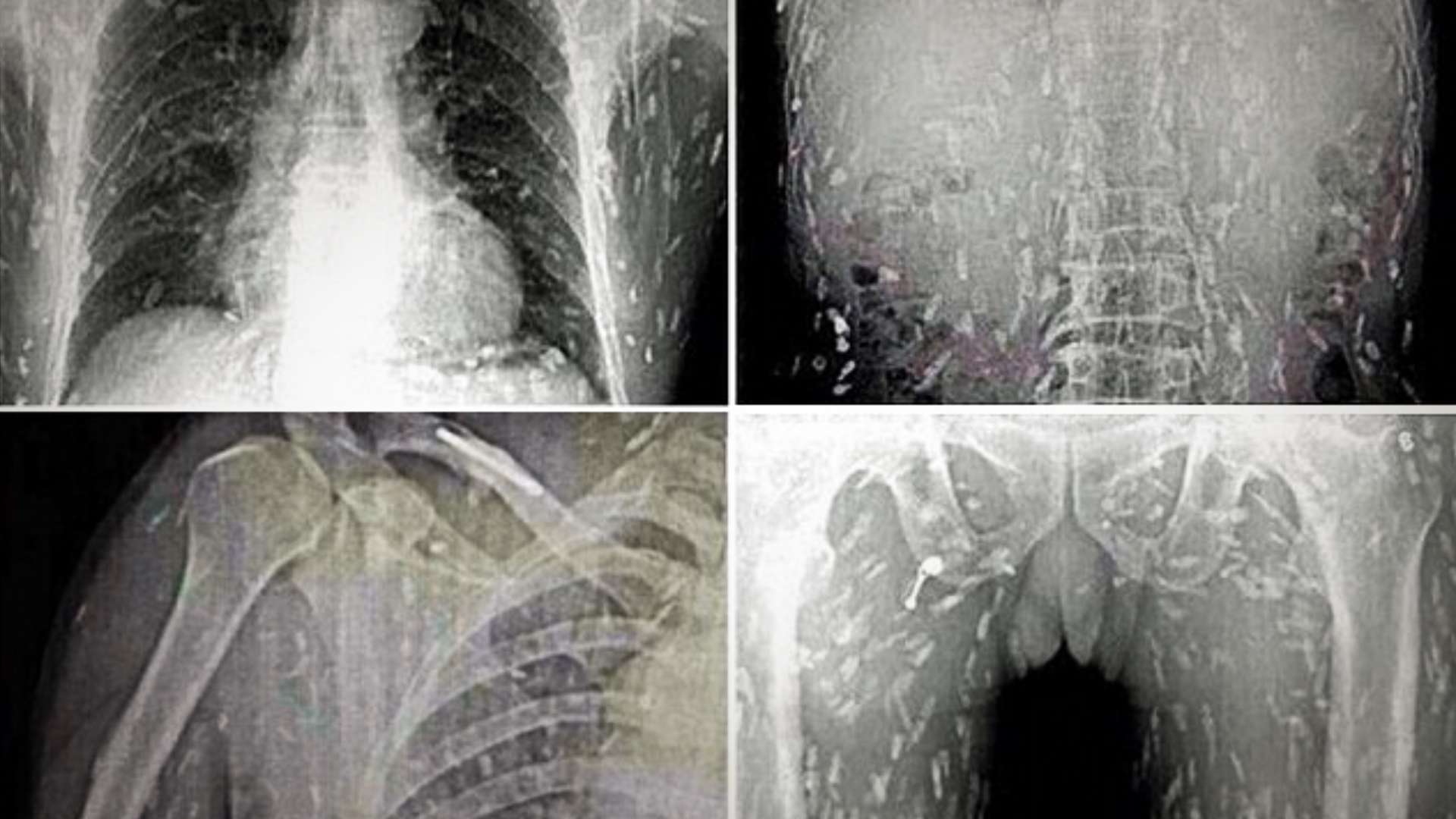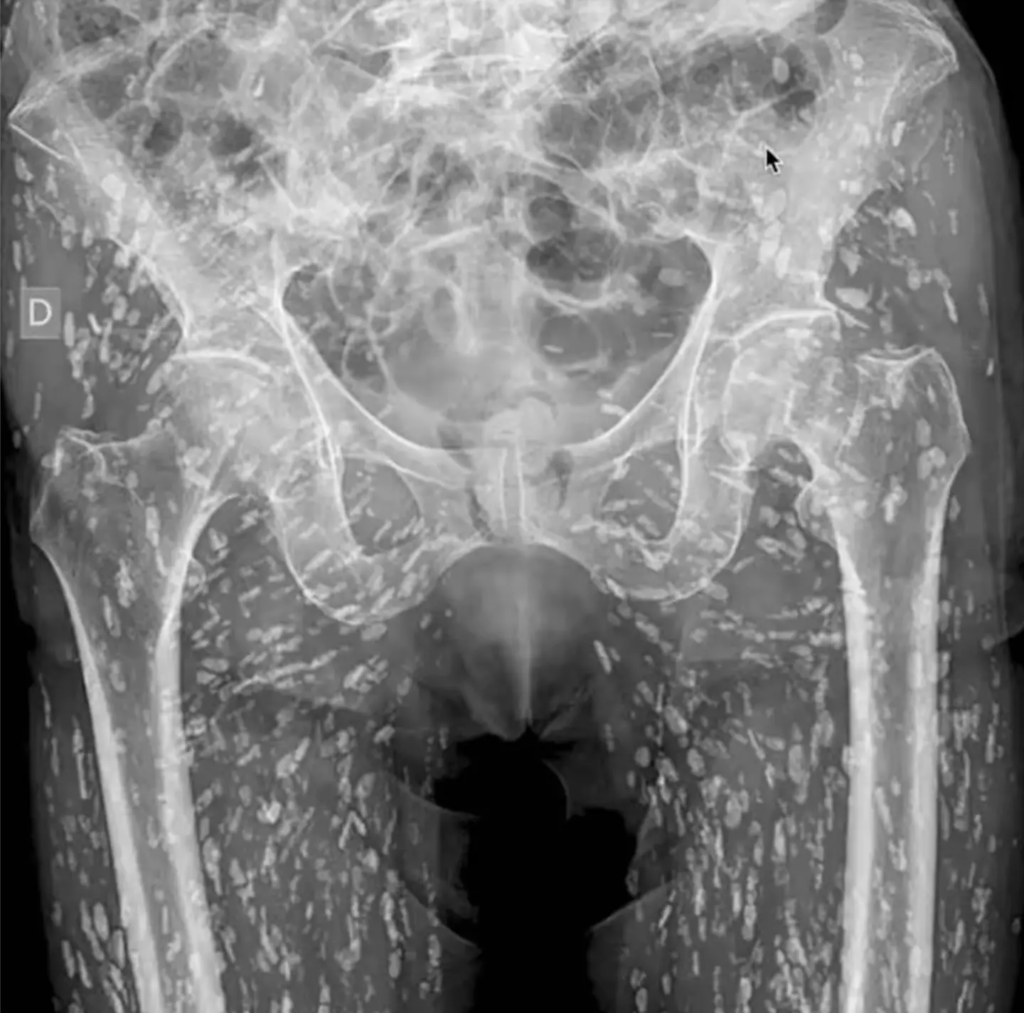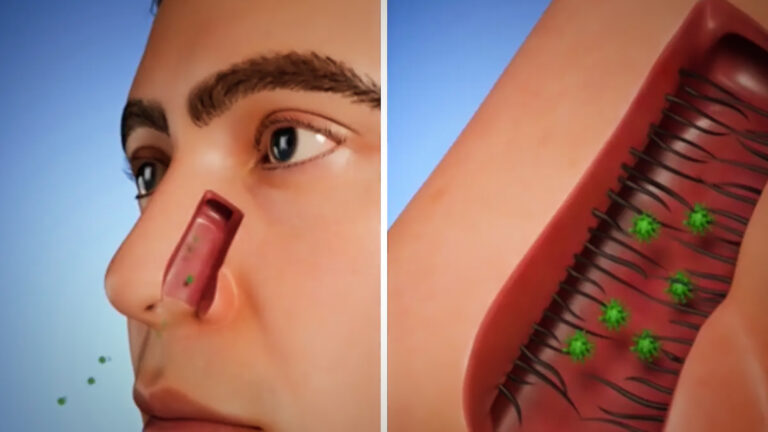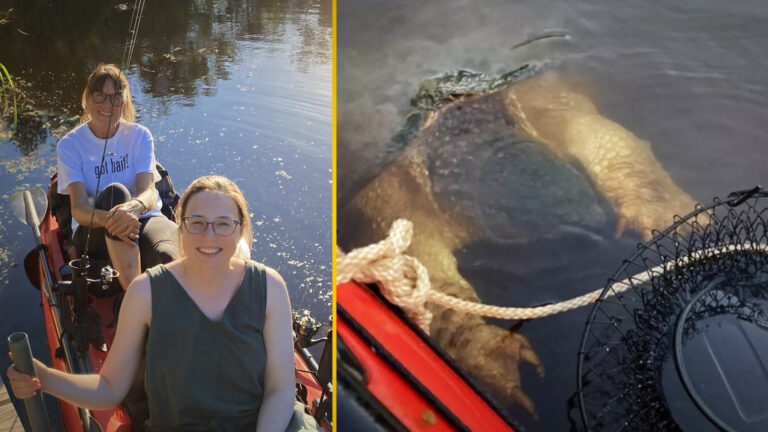Disturbing X-ray Reveals a Body Infested With Tapeworms: The Shocking Consequences of a Kitchen Mistake

An unsettling X-ray showing a body filled with tapeworms has been making waves on social media, shedding light on the hidden dangers of improperly prepared food. Experts are now warning about the serious consequences of this infection and how it can be prevented.
A Disturbing Discovery: The X-ray That Shocked Experts
On January 16, 2025, Dr. Sam Ghali, a physician at the University of Florida, posted a truly disturbing X-ray image on his social media platform, X (formerly Twitter). The image, which showed a body infested with tapeworms, left many viewers stunned. Dr. Ghali called it “one of the most insane X-rays I’ve ever seen,” drawing attention to an infection that can be contracted from a common kitchen mistake.
The X-ray image instantly went viral, with viewers reacting in disbelief as the sheer scale of the tapeworm infestation became clear. Many expressed shock over the amount of tapeworm larvae visible in the image, while others shared their own fears of unknowingly consuming contaminated food. Tapeworm infections like this one highlight the importance of understanding how these parasites spread and the potential health risks that may not always be immediately visible.
Tapeworm Infections: A Silent Threat
The most unsettling part of this discovery is that the tapeworm larvae, known as cysticerci, can invade various organs, including the muscles, brain, and eyes, potentially leading to life-threatening complications. Cysticercosis, often linked to improperly cooked pork, can go undetected for a long time, making it even more dangerous. Without immediate intervention, the infection can lead to severe neurological and muscular complications that can persist for years. It’s also not limited to pork, as certain environmental conditions can help propagate these infections, making it important to consider the source of the food. People living in regions with poor sanitation or hygiene practices may be more susceptible to such infections.
The CDC highlights that while the infection rate is low, the long-term health complications make it vital for individuals to be educated about its risks. Additionally, cysticercosis can be transmitted through water or food contaminated with tapeworm eggs. This shows the importance of both cooking food properly and maintaining high levels of personal hygiene and sanitation.
What Is Cysticercosis?
According to the Centers for Disease Control and Prevention (CDC), cysticercosis is caused by the larvae of the Taenia solium tapeworm. Here’s how it works:
- Eggs from the Tapeworm: A person becomes infected by consuming food or water contaminated with tapeworm eggs. These eggs are microscopic and may not always be visible to the naked eye, making them incredibly difficult to detect in everyday food handling.
- Hatching and Penetration: The eggs hatch inside the intestines, and the larvae move through the intestinal wall into other tissues, including muscles, eyes, and the brain. Once they infiltrate various parts of the body, they begin to form cysts, which can lead to inflammation and other medical issues.
- Cyst Development: These larvae form cysts, known as cysticerci, which can grow into larger masses, leading to serious health issues. The cysts can range from small to large and may cause damage to the affected organ over time. They can remain in the body for years before symptoms manifest, which is why timely detection and treatment are critical.

The CDC points out that cysticercosis can be found in different stages in various parts of the body. The muscles, eyes, and brain are particularly at risk. The body can harbor numerous cysts, with some appearing near the skin and others deep inside the organs.
Learn More: Explore further details about cysticercosis from the CDC’s official page on cysticercosis.
Could Undercooked Pork Be the Culprit?
Dr. Ghali speculates that the individual in the X-ray might have contracted cysticercosis through the consumption of undercooked pork. However, the CDC has clarified that simply eating undercooked pork isn’t enough to cause this infection. The pork must be infected with cysticerci to be harmful. This means that cooking pork thoroughly can significantly reduce the risk of infection, but it’s not fool proof if contamination has already occurred.
While it’s easy to assume that undercooked pork is the sole cause of such infections, it’s important to remember that cysticercosis can also occur when food or water is contaminated with tapeworm eggs. These microscopic eggs can remain on unwashed produce or in contaminated water, making it essential to practice cleanliness when handling food. The most common symptoms of cysticercosis often arise after the cysts reach the brain, causing neurological disturbances such as headaches, seizures, or even paralysis.
To understand the conditions under which cysticercosis can be contracted, you can check out the CDC’s guidelines on food safety and preventing parasitic infections.
The Dangers of Cysticercosis: A Growing Threat to Health
As Dr. Ghali explains in the video accompanying the X-ray, the cysts formed by the larvae can travel throughout the body, particularly affecting the muscles and soft tissues in the hips and legs. While these cysts may not be immediately life-threatening if located in the pelvis, they can become extremely dangerous if they travel to the brain. Brain cysts can cause severe neurological issues, making it difficult for doctors to diagnose early on.
When cysts lodge in the brain, they can cause neurological symptoms, including:
- Headaches: Persistent headaches that worsen over time.
- Confusion: Cognitive disturbances leading to difficulty focusing or performing daily tasks.
- Seizures: This is a common symptom when cysts are in the brain, and they can range from mild to severe.
- Potentially fatal consequences: In extreme cases, brain cysts can lead to paralysis, comas, or even death if left untreated.
If the infection is not addressed early, it can result in long-term health complications. Surgery or medical intervention may be required to remove the cysts, and the recovery process can be lengthy.
How to Avoid Cysticercosis
While it’s difficult to completely eliminate the risk of contracting cysticercosis from undercooked pork, there are several measures you can take to minimize the chances of infection. According to the CDC:
- Proper Food Preparation: Ensure that pork is thoroughly cooked to kill any potential tapeworm larvae. The meat should reach a safe internal temperature, and cutting boards and utensils should be disinfected to avoid cross-contamination.
- Cleanliness is Key: Maintain high levels of cleanliness in the kitchen to avoid contamination of food and water. Washing your hands and utensils frequently, especially after handling raw meat, is one of the best preventive measures.
- Water Safety: Be cautious about the water you consume, particularly in regions with poor sanitation. Avoid drinking untreated water, and make sure that all food and beverages are sourced from clean, reliable places.
In addition to these precautions, travellers to regions with higher risks of parasitic infections should take extra care to follow safe food and water handling practices.
Learn More: Check out these safe cooking tips for pork.
Cysticercosis in Developing Countries: A Growing Concern
Those living in areas with poor sanitation, particularly in regions of Africa, Asia, and Latin America, are at a significantly higher risk for contracting cysticercosis. In these areas, the absence of proper sanitation facilities increases the likelihood of tapeworm eggs being transmitted through contaminated food or water. People in rural or underserved communities may lack access to the sanitation infrastructure needed to prevent these infections.
Here's a video I made breaking down one of the most insane X-Rays I've ever seen#FOAMed pic.twitter.com/wp8xtGFTV5
— Sam Ghali, M.D. (@EM_RESUS) January 16, 2025
The CDC emphasizes that improving sanitation and access to clean water could drastically reduce the occurrence of parasitic infections like cysticercosis in these vulnerable populations. Additionally, health education is critical to preventing the spread of tapeworms, as many people may be unaware of the risks associated with contaminated food and water. Proper hygiene, better sanitation, and education are essential to combating this issue.
Explore More: Read about the challenges of sanitation in developing countries and how they contribute to health issues like cysticercosis in this in-depth article on global sanitation.
Social Media Reactions to the X-ray
The shocking X-ray of a body infested with tapeworms quickly sparked reactions across social media. Many people expressed their disbelief and horror over the image, while others shared their own experiences or knowledge about tapeworm infections. Here are a couple of notable social media reactions:
Twitter Post 1:
“This X-ray is enough to make me reconsider everything I eat. Be careful with your food, folks. #Cysticercosis #HealthHorrors”
Check out the post on Twitter
Instagram Post 1:
“Just saw the most insane X-ray of a body infested with tapeworms. Who knew that a kitchen mistake could lead to something this severe? Be cautious with your food choices. #Cysticercosis #Parasites”
See the post on Instagram
Twitter Post 2:
“I’ve never seen an X-ray like this before. Health is wealth, everyone. Protect yourself. #FoodSafety #ParasiteInfection”
See the reaction on Twitter
Final Thoughts: The Hidden Dangers of Improperly Prepared Food
Dr. Ghali’s viral post serves as a stark reminder of the potential dangers lurking in improperly cooked food. While cysticercosis is a rare and extreme example, it underscores the importance of food safety and hygiene in preventing a wide range of infections. It’s essential to remain vigilant and cautious, especially when preparing pork or other meats at home.
As modern health advice stresses, ensuring that pork is cooked thoroughly and maintaining a clean kitchen are simple but effective steps we can all take to safeguard our health.
Let Otis Johnson’s experience be a wake-up call to appreciate the complexities of modern food safety and the unseen dangers that exist around us.






